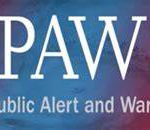The Integrated Public Alert and Warning System (IPAWS) is an architecture that unifies the United States’ Emergency Alert System, National Warning System, Wireless Emergency Alerts, and NOAA Weather Radio, under a single platform. IPAWS was designed to modernize these systems by enabling alerts to be aggregated over a network and distributed to the appropriate system for public dissemination.
The program is organized and funded by the Federal Emergency Management Agency (FEMA), an agency of the Department of Homeland Security. The system allows for alerts to be originated by Federal, State, local and tribal officials, and subsequently disseminated to the public using a range of national and local alerting systems including EAS, CMAS and NWR.[5] The system uses open standard digital formats such as the EDXL-based Common Alerting Protocol v1.2 for its messages, allowing for interoperable dissemination to a wide range of third party receivers.

Desktop Alert enables the Nation’s military, and civilian emergency response teams to communicate emergency messages in seconds to global networks and targeted users. Highly secure, Desktop Alert is the only US internal communications company with DISA certification from the DoD and, is the sole provider to NATO worldwide. Desktop Alert can broadcast FEMA, NOAA, CAP and IPAWS alerts. The US Army, US Air Force, The United States Military Academy at West Point and the National Guard are among our clients who utilize the DTA mass notification platform.
History
In June 2006, following criticism over the government’s response to Hurricane Katrina, President George W. Bush signed Executive Order 13407[2] ordering the Secretary of Homeland Security to establish a new program to integrate and modernize the nation’s existing population warning systems. These systems include the:
- Emergency Alert System (EAS),
- National Warning System (NAWAS),
- Wireless Emergency Alerts (WEA, formerly known as the Commercial Mobile Alert System (CMAS), and
- NOAA Weather Radio All Hazards.
The new network, subsequently termed the Integrated Public Alert and Warning System (IPAWS) is designed to integrate these various systems into one modern network, and also update them to take into account newer forms of communication such as cellular telephony and Cell Broadcast, satellite and cable television, electronic billboards and the internet.





